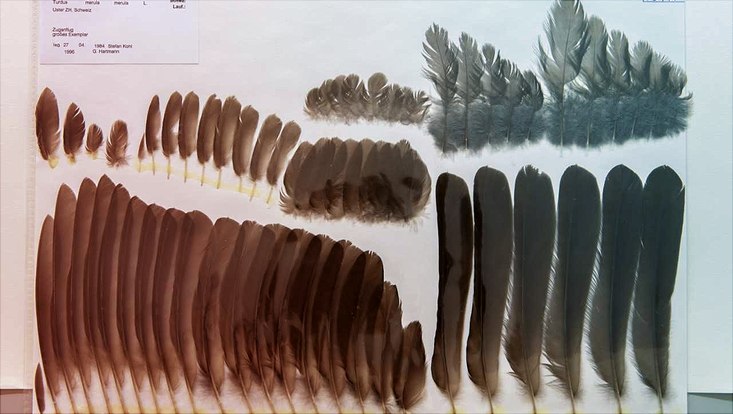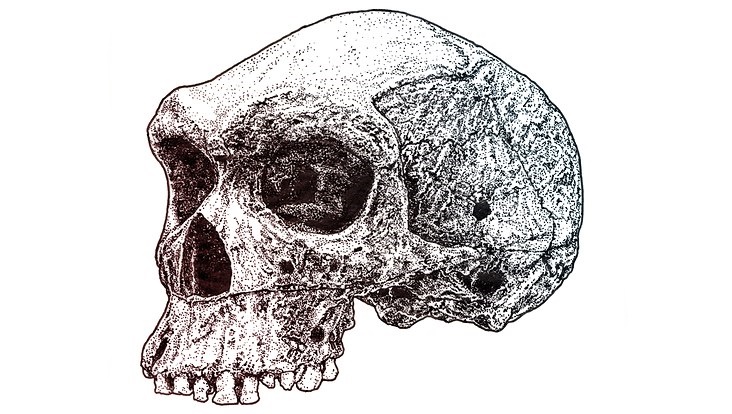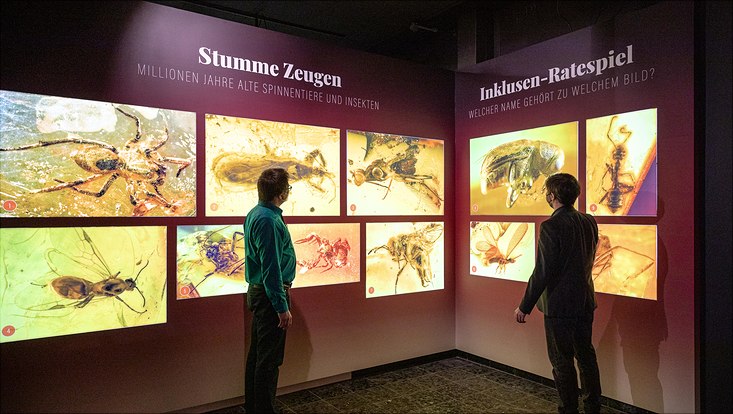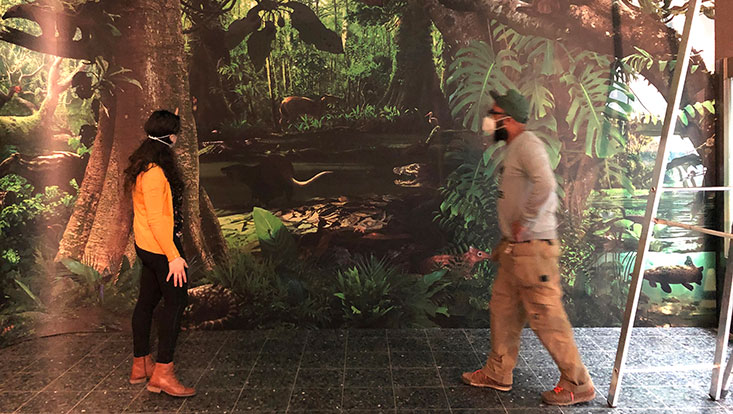
Preparing for the new start: a look behind the museum doors
17 April 2020

Photo: Foto: UHH/CeNak, Bein
Anne Marie Rahn nutzt die Phase des geschlossenen Museums, um Federn aus dem Museumsfundus zu sichten. Jede Feder liefert ihr Informationen über deren ehemaligen Besitzer und die Funktion.
It has also become lonely for Antje the walrus and Smilla the polar bear. The Zoological Museum is currently closed due to the Corona pandemic. But not for Marie Rahn, who is now finding time to develop new formats for workshops and guided tours of the exhibition. A conversation with the deputy head of the department "Scientific Education and Visitor Management" about, among other things, her work with feathers and skins and why digital offerings are no substitute for a visit to the museum.
How does it feel to be in a museum without visitors - what do you miss?
Marie Rahn: We are in a completely unexpected and, for very many people, decidedly difficult situation. Of course, our doors have had to remain closed to the public for several weeks now.
Accordingly, where people of all ages normally go on a discovery tour, laugh, marvel, devoutly admire our exhibits or have animated conversations about them with our guides and staff, there is now yawning emptiness. But our museums are by no means completely empty: while we are sadly missing our visitors and the lively exchange with them at the moment, we are at least busily using the time behind the scenes to prepare the longed-for new start.
What new/old programs can visitors look forward to when the museum reopens?
Marie Rahn: Our proven and popular programs, such as native animals and dinosaurs, will of course continue in the future.
However, there will be a few "updates" waiting for our visitors: We are currently preparing a few new handpieces, pictures and information for our programs and are also developing them a little further.

In addition, we already have a whole range of other formats and topics in mind: In addition to offers with and about our bird world, there will soon be a small series of events for adults and young people in the Mineralogical Museum, for example, we are planning workshops on the topic of bionics and are currently already drafting the first possible offers and content for our next, certainly very exciting special exhibition.
What is the core idea of science education for you - what do you want to convey?
Marie Rahn: Museums have an educational mission; they are repositories of knowledge, social meeting places, places of learning and experience.
At the Centrum für Naturkunde, the three museums are backed by a research institute with more than 10 million objects in its non-public collections, which conducts diverse and important scientific work at the local, regional, and international levels on the transformation of biodiversity.
Accordingly, the task of our outreach work is to illustrate the contents of our exhibitions in a generally understandable and versatile way, while always making the research processes and collection activities comprehensible.
We are the first point of contact for our visitors and always seek dialogue with them. We want to answer their questions and take up their suggestions, but we also want to arouse their curiosity about other topics, inspire and activate them, and work with them to preserve biodiversity and use natural resources sustainably.
Not least, the Internet today offers numerous images, films and - depending on the provider - reliable, but sometimes unfortunately also completely abstruse content on animals and natural phenomena. Virtually, I can even bring a tiger or a polar bear into my own living room, but seeing the "originals" in a museum still has a much more intense effect. They all have their own story to tell, can be viewed up close in peace and quiet and are fascinating, for example, because of their size, their colors, their shape or their diversity. Some of the more than 1,500 animals in our exhibitions are also unfortunately very rare (now), already extinct or could not be kept in a zoo.
We are happy to inform our visitors about how and where our fellow inhabitants lived, why and how they came to us, how they were placed and what new research results there are on them. The majority of our exhibits are actually specimens with the real skin, fur, feathers, claws or horns.
With our research institute behind us, we are also in an even better position to provide our public with scientifically sound information and the latest findings in a timely manner.
What does the museum's work "behind the scenes" currently look like?
Marie Rahn: We are always fortunate to receive new original material that we can use especially for our workshops and guided tours with young and old. We are very happy about this, because it is especially important to us to make tactile experiences possible. Our exhibits in the exhibitions may not be touched, but in our programs we like to work with hands-on pieces - touching, exploring for yourself and discovering exciting details are always part of the experience.
When the picture of me with the feathers was taken a few days ago, I was sifting through some of the feathers from our collection in the Zoological Museum's activity room. When I was little, we used to raise birds at home. Since then, I have been fascinated by them and enjoy studying their feathers, among other things.
Every single feather that might catch my eye outside on a walk can tell me a lot about its former owner and its actual function if I take a closer look at it: What color is it? Does it have a particular "pattern"? How big is it? What kind of shape does it have? Is it perhaps a tail feather? Or is it from the breast, back, or a particular part of the wing? Is it shiny? Is the edge finely frayed or sharply defined?
The answers to such questions will help identify which bird wore them. I may even be able to draw conclusions about the reason it was lost based on its condition. To "read" feathers is in principle not difficult and with a little practice easy to learn.
On the picture ... you can see e.g. feathers of a blackbird from our scientific collection. They all come from a female and even if there seems to be little difference in color, it is still clear that the shapes of the feathers are very diverse depending on their position and task. A second look is always worthwhile!
Here in Hamburg alone, there are over 160 species of breeding birds that we can encounter - more than in Berlin! To protect them properly and thus preserve their diversity is only possible if we know them and understand their lifestyles and needs, so it is very important to me to convey knowledge about this to our audience. I am currently compiling the relevant material so that we can make greater use of it in our campaigns in the future.
What is one of your heartfelt projects that you have in mind for the next few weeks/months?
Marie Rahn: A very special complex of topics, which fascinates me very much and has also moved me for a long time, is for me our own (biocultural) evolution and with it our dispersion from Africa. There are numerous highly interesting current research approaches and projects on this. I am passionately engaged in the question of how information on this can be conveyed as effectively, vividly and participatively as possible.
After I had already created didactic materials on our development accompanying a special exhibition together with a very esteemed colleague in Frankfurt some time ago, I was also allowed to draw some fossils for the new edition of Prof. Friedemann Schrenk's "Die Frühzeit des Menschen" (The Early History of Man) meanwhile almost two years ago. (see drawing)
In addition I had the luck to visit original sites in Malawi, Tanzania and Georgia several times and I am in active contact with the dedicated colleagues in the museums there. I have also been working with them for a long time on a project and ultimately also on my own work on new possibilities of museum mediation and an international linking of museum visitors. The goal is to interest a larger audience in our family history, which spans millions of years, and at the same time to encourage them to reflect on the way we treat each other today. Because this much is clear: we need a new common understanding of history and actual cooperation at eye level if we are serious about putting aside prejudices and Eurocentric ways of thinking and shaping our world in the future for the benefit of all on an equal footing.



